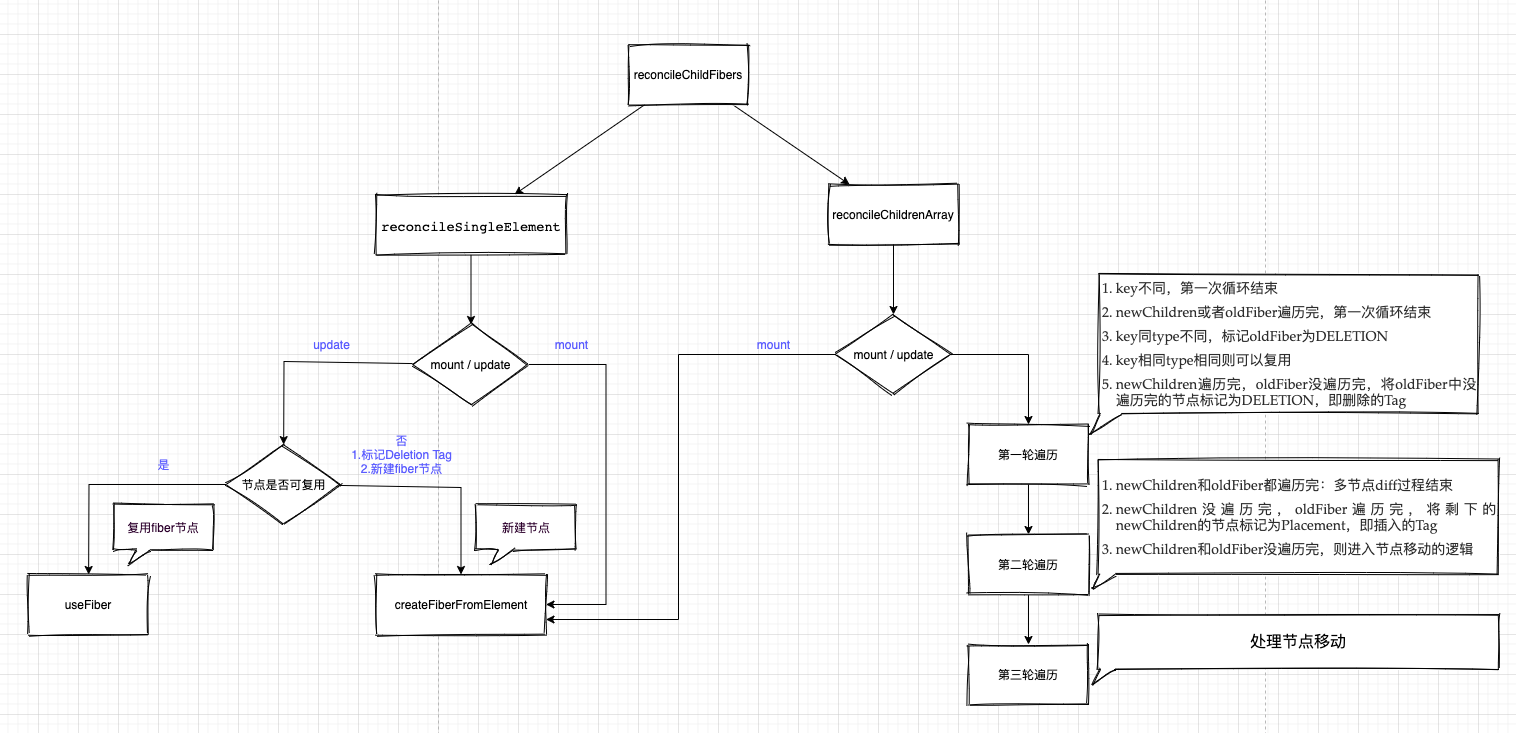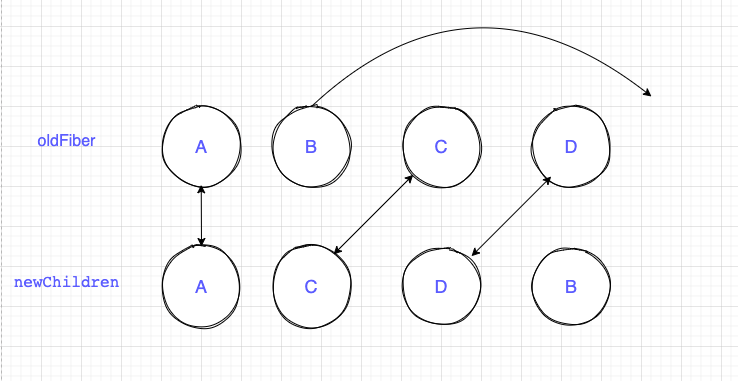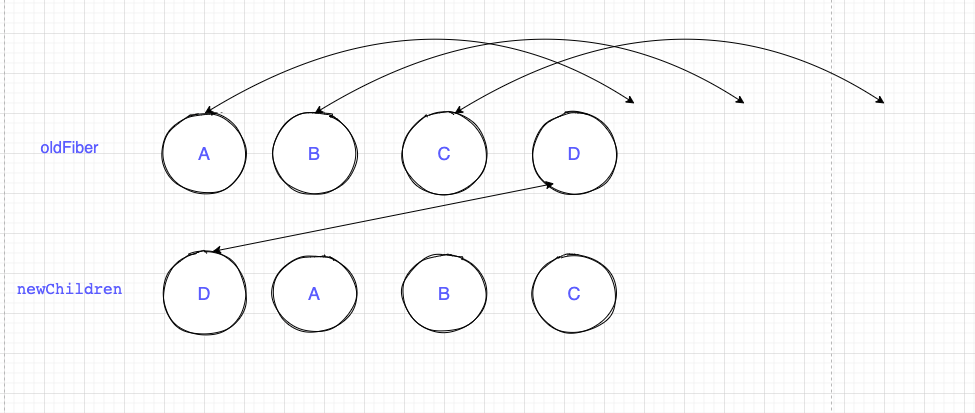人人都能读懂的react源码解析(大厂高薪必备)
8.diff算法(妈妈再也不担心我的diff面试了)
视频课程&调试demos
视频课程的目的是为了快速掌握react源码运行的过程和react中的scheduler、reconciler、renderer、fiber等,并且详细debug源码和分析,过程更清晰。
视频课程:进入课程
demos:demo
课程结构:
- 开篇(听说你还在艰难的啃react源码)
- react心智模型(来来来,让大脑有react思维吧)
- Fiber(我是在内存中的dom)
- 从legacy或concurrent开始(从入口开始,然后让我们奔向未来)
- state更新流程(setState里到底发生了什么)
- render阶段(厉害了,我有创建Fiber的技能)
- commit阶段(听说renderer帮我们打好标记了,映射真实节点吧)
- diff算法(妈妈再也不担心我的diff面试了)
- hooks源码(想知道Function Component是怎样保存状态的嘛)
- scheduler&lane模型(来看看任务是暂停、继续和插队的)
- concurrent mode(并发模式是什么样的)
- 手写迷你react(短小精悍就是我)
在render阶段更新Fiber节点时,我们会调用reconcileChildFibers对比current Fiber和jsx对象构建workInProgress Fiber,这里current Fiber是指当前dom对应的fiber树,jsx是class组件render方法或者函数组件的返回值。
在reconcileChildFibers中会根据newChild的类型来进入单节点的diff或者多节点diff
function reconcileChildFibers(
returnFiber: Fiber,
currentFirstChild: Fiber | null,
newChild: any,
): Fiber | null {
const isObject = typeof newChild === 'object' && newChild !== null;
if (isObject) {
switch (newChild.$$typeof) {
case REACT_ELEMENT_TYPE:
//单一节点diff
return placeSingleChild(
reconcileSingleElement(
returnFiber,
currentFirstChild,
newChild,
lanes,
),
);
}
}
//...
if (isArray(newChild)) {
//多节点diff
return reconcileChildrenArray(
returnFiber,
currentFirstChild,
newChild,
lanes,
);
}
// 删除节点
return deleteRemainingChildren(returnFiber, currentFirstChild);
}
diff过程的主要流程如下图:

我们知道对比两颗树的复杂度本身是O(n3),对我们的应用来说这个是不能承受的量级,react为了降低复杂度,提出了三个前提:
-
只对同级比较,跨层级的dom不会进行复用
-
不同类型节点生成的dom树不同,此时会直接销毁老节点及子孙节点,并新建节点
-
可以通过key来对元素diff的过程提供复用的线索,例如:
const a = ( <> <p key="0">0</p> <p key="1">1</p> </> ); const b = ( <> <p key="1">1</p> <p key="0">0</p> </> ); 如果a和b里的元素都没有key,因为节点的更新前后文本节点不同,导致他们都不能复用,所以会销毁之前的节点,并新建节点,但是现在有key了,b中的节点会在老的a中寻找key相同的节点尝试复用,最后发现只是交换位置就可以完成更新,具体对比过程后面会讲到。
单节点diff
单点diff有如下几种情况:
- key和type相同表示可以复用节点
- key不同直接标记删除节点,然后新建节点
- key相同type不同,标记删除该节点和兄弟节点,然后新创建节点
function reconcileSingleElement( returnFiber: Fiber, currentFirstChild: Fiber | null, element: ReactElement ): Fiber { const key = element.key; let child = currentFirstChild; //child节点不为null执行对比 while (child !== null) { // 1.比较key if (child.key === key) { // 2.比较type switch (child.tag) { //... default: { if (child.elementType === element.type) { // type相同则可以复用 返回复用的节点 return existing; } // type不同跳出 break; } } //key相同,type不同则把fiber及和兄弟fiber标记删除 deleteRemainingChildren(returnFiber, child); break; } else { //key不同直接标记删除该节点 deleteChild(returnFiber, child); } child = child.sibling; } //新建新Fiber }多节点diff
多节点diff比较复杂,我们分三种情况进行讨论,其中a表示更新前的节点,b表示更新后的节点
-
属性变化
const a = ( <> <p key="0" name='0'>0</p> <p key="1">1</p> </> ); const b = ( <> <p key="0" name='00'>0</p> <p key="1">1</p> </> ); -
type变化
const a = ( <> <p key="0">0</p> <p key="1">1</p> </> ); const b = ( <> <div key="0">0</div> <p key="1">1</p> </> ); -
新增节点
const a = ( <> <p key="0">0</p> <p key="1">1</p> </> ); const b = ( <> <p key="0">0</p> <p key="1">1</p> <p key="2">2</p> </> ); -
节点删除
const a = ( <> <p key="0">0</p> <p key="1">1</p> <p key="2">2</p> </> ); const b = ( <> <p key="0">0</p> <p key="1">1</p> </> ); -
节点位置变化
const a = ( <> <p key="0">0</p> <p key="1">1</p> </> ); const b = ( <> <p key="1">1</p> <p key="0">0</p> </> );
在源码中多节点diff会经历三次遍历,第一次遍历处理节点的更新(包括props更新和type更新和删除),第二次遍历处理其他的情况(节点新增),其原因在于在大多数的应用中,节点更新的频率更加频繁,第三次处理位节点置改变
-
第一次遍历
因为老的节点存在于current Fiber中,所以它是个链表结构,还记得Fiber双缓存结构嘛,节点通过child、return、sibling连接,而newChildren存在于jsx当中,所以遍历对比的时候,首先让newChildren[i]
与oldFiber对比,然后让i++、nextOldFiber = oldFiber.sibling。在第一轮遍历中,会处理三种情况,其中第1,2两种情况会结束第一次循环- key不同,第一次循环结束
- newChildren或者oldFiber遍历完,第一次循环结束
- key同type不同,标记oldFiber为DELETION
- key相同type相同则可以复用
newChildren遍历完,oldFiber没遍历完,在第一次遍历完成之后将oldFiber中没遍历完的节点标记为DELETION,即删除的DELETION Tag
-
第二次遍历
第二次遍历考虑三种情况
1. newChildren和oldFiber都遍历完:多节点diff过程结束 2. newChildren没遍历完,oldFiber遍历完,将剩下的newChildren的节点标记为Placement,即插入的Tag- newChildren和oldFiber没遍历完,则进入节点移动的逻辑
-
第三次遍历
主要逻辑在placeChild函数中,例如更新前节点顺序是ABCD,更新后是ACDB
-
newChild中第一个位置的A和oldFiber第一个位置的A,key相同可复用,lastPlacedIndex=0
-
newChild中第二个位置的C和oldFiber第二个位置的B,key不同跳出第一次循环,将oldFiber中的BCD保存在map中
-
newChild中第二个位置的C在oldFiber中的index=2 > lastPlacedIndex=0不需要移动,lastPlacedIndex=2
-
newChild中第三个位置的D在oldFiber中的index=3 > lastPlacedIndex=2不需要移动,lastPlacedIndex=3
-
newChild中第四个位置的B在oldFiber中的index=1 < lastPlacedIndex=3,移动到最后
看图更直观

-
例如更新前节点顺序是ABCD,更新后是DABC
-
newChild中第一个位置的D和oldFiber第一个位置的A,key不相同不可复用,将oldFiber中的ABCD保存在map中,lastPlacedIndex=0
-
newChild中第一个位置的D在oldFiber中的index=3 > lastPlacedIndex=0不需要移动,lastPlacedIndex=3
-
newChild中第二个位置的A在oldFiber中的index=0 < lastPlacedIndex=3,移动到最后
-
newChild中第三个位置的B在oldFiber中的index=1 < lastPlacedIndex=3,移动到最后
-
newChild中第四个位置的C在oldFiber中的index=2 < lastPlacedIndex=3,移动到最后
看图更直观

代码如下:
function placeChild(newFiber, lastPlacedIndex, newIndex) { newFiber.index = newIndex; if (!shouldTrackSideEffects) { return lastPlacedIndex; } var current = newFiber.alternate; if (current !== null) { var oldIndex = current.index; if (oldIndex < lastPlacedIndex) { //oldIndex小于lastPlacedIndex的位置 则将节点插入到最后 newFiber.flags = Placement; return lastPlacedIndex; } else { return oldIndex;//不需要移动 lastPlacedIndex = oldIndex; } } else { //新增插入 newFiber.flags = Placement; return lastPlacedIndex; } }
function reconcileChildrenArray( returnFiber: Fiber,//父fiber节点 currentFirstChild: Fiber | null,//childs中第一个节点 newChildren: Array<*>,//新节点数组 也就是jsx数组 lanes: Lanes,//lane相关 第12章介绍 ): Fiber | null { let resultingFirstChild: Fiber | null = null;//diff之后返回的第一个节点 let previousNewFiber: Fiber | null = null;//新节点中上次对比过的节点 let oldFiber = currentFirstChild;//正在对比的oldFiber let lastPlacedIndex = 0;//上次可复用的节点位置 或者oldFiber的位置 let newIdx = 0;//新节点中对比到了的位置 let nextOldFiber = null;//正在对比的oldFiber for (; oldFiber !== null && newIdx < newChildren.length; newIdx++) {//第一次遍历 if (oldFiber.index > newIdx) {//nextOldFiber赋值 nextOldFiber = oldFiber; oldFiber = null; } else { nextOldFiber = oldFiber.sibling; } const newFiber = updateSlot(//更新节点,如果key不同则newFiber=null returnFiber, oldFiber, newChildren[newIdx], lanes, ); if (newFiber === null) { if (oldFiber === null) { oldFiber = nextOldFiber; } break;//跳出第一次遍历 } if (shouldTrackSideEffects) {//检查shouldTrackSideEffects if (oldFiber && newFiber.alternate === null) { deleteChild(returnFiber, oldFiber); } } lastPlacedIndex = placeChild(newFiber, lastPlacedIndex, newIdx);//标记节点插入 if (previousNewFiber === null) { resultingFirstChild = newFiber; } else { previousNewFiber.sibling = newFiber; } previousNewFiber = newFiber; oldFiber = nextOldFiber; } if (newIdx === newChildren.length) { deleteRemainingChildren(returnFiber, oldFiber);//将oldFiber中没遍历完的节点标记为DELETION return resultingFirstChild; } if (oldFiber === null) { for (; newIdx < newChildren.length; newIdx++) {//第2次遍历 const newFiber = createChild(returnFiber, newChildren[newIdx], lanes); if (newFiber === null) { continue; } lastPlacedIndex = placeChild(newFiber, lastPlacedIndex, newIdx);//插入新增节点 if (previousNewFiber === null) { resultingFirstChild = newFiber; } else { previousNewFiber.sibling = newFiber; } previousNewFiber = newFiber; } return resultingFirstChild; } // 将剩下的oldFiber加入map中 const existingChildren = mapRemainingChildren(returnFiber, oldFiber); for (; newIdx < newChildren.length; newIdx++) {//第三次循环 处理节点移动 const newFiber = updateFromMap( existingChildren, returnFiber, newIdx, newChildren[newIdx], lanes, ); if (newFiber !== null) { if (shouldTrackSideEffects) { if (newFiber.alternate !== null) { existingChildren.delete(//删除找到的节点 newFiber.key === null ? newIdx : newFiber.key, ); } } lastPlacedIndex = placeChild(newFiber, lastPlacedIndex, newIdx);//标记为插入的逻辑 if (previousNewFiber === null) { resultingFirstChild = newFiber; } else { previousNewFiber.sibling = newFiber; } previousNewFiber = newFiber; } } if (shouldTrackSideEffects) { //删除existingChildren中剩下的节点 existingChildren.forEach(child => deleteChild(returnFiber, child)); } return resultingFirstChild; } -